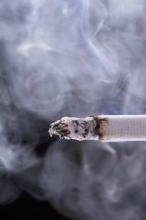Smoking significantly raises the risk that patients with systemic lupus erythematosus will develop active cutaneous manifestations of the disease, based on data from a multicenter cohort study of 1,346 patients.
Overall, current smokers were 63% more likely than former or never smokers to have an active SLE rash after controlling for multiple variables. In addition, patients who had ever smoked were more than twice as likely to meet the American College of Rheumatology criteria for discoid rash (odds ratio, 2.36) and photosensitivity (odds ratio, 1.47).
The study is the largest to date examining the effect of smoking on cutaneous outcomes in systemic lupus erythematosus (SLE), said Dr. Josiane Bourré-Tessier of the University of Montreal and her associates.
The researchers examined a possible association between smoking status and skin activity using data from the 1000 Faces of Lupus Cohort, a cohort of SLE patients who presented for care at 14 participating specialty clinics across Canada. The study population included 1,346 participants aged 16 years and older who enrolled between 2005 and 2009 (Arthritis Care Res. 2013 Feb. 11 [doi:10.1002/acr.21966]).
The patients were assessed using the SLE Disease Activity Index 2000 (SLEDAI-2K), which focuses on rash and alopecia; the Systemic Lupus International Collaborating Clinics/ACR Damage Index (SDI), which focuses on alopecia, extensive scarring, and skin ulceration; and the American College of Rheumatology (ACR) revised criteria for SLE, which focus on discoid rash, malar rash, and photosensitivity.
More than 90% of the study subjects were women, and 63% were white. The mean age was 47 years; mean disease duration was 13 years. Approximately 14% of the patients were current smokers and 27% were past smokers.
Most patients (70%) were taking antimalarials at the time of the study – 64% taking hydroxychloroquine and 6% taking chloroquine. Another 35% were taking immunosuppressants.
According to the SLEDAI-2K, 28% of patients had some mucocutaneous disease activity: 15% had rash, 13% had alopecia, 8% had mucosal ulcers, and 8% had at least two of these symptoms. According to the SDI, 12% had alopecia, including 4% with extensive scarring and 0.2% with skin ulceration. According to ACR criteria, 60% of patients had ever experienced malar rash; 17% had experienced discoid rash; 56%, photosensitivity; and 56%, ulcerations.
No association was found between past smoking and active skin manifestations, based on the SLEDAI-2K.
Based on the SDI, there was no association between smoking and cutaneous damage. This finding, however, may be due to the small number of patients with cutaneous damage, the researchers said. Alternatively, it may suggest that a longer observation period is needed to show a relationship between smoking and long-term cutaneous damage.
Both current and past smoking were associated with discoid rash and photosensitivity, based on the ACR criteria. Since ACR criteria are cumulative, this finding suggests that past smoking "may have triggered the prior emergence of cutaneous criteria," Dr. Bourré-Tessier and her associates said.
The association between smoking and skin manifestations of SLE "is not surprising, as cigarettes contain multiple chemical factors that may generate free radicals and alter inflammatory cell function and extracellular matrix turnover," the researchers wrote.
"These chemical factors may also interact with DNA and promote the production of autoantibodies directed against altered DNA," they suggested.
It was encouraging to find that current, but not past, smoking was associated with skin activity because that suggests the adverse effect may be reversible if patients stop smoking, the researchers noted.
The findings support the results of previous investigations showing that smoking promotes disease activity in a variety of autoimmune conditions. The data also give clinicians added incentive to encourage SLE patients to quit smoking, Dr. Bourré-Tessier and her associates said.
The study was limited by an inability to account for potential confounders such as medication adherence and sun exposure, they added.
The 1000 Faces of Lupus Cohort was funded by the Arthritis Society and the Lupus Society of Manitoba. No financial conflicts of interest were reported.


